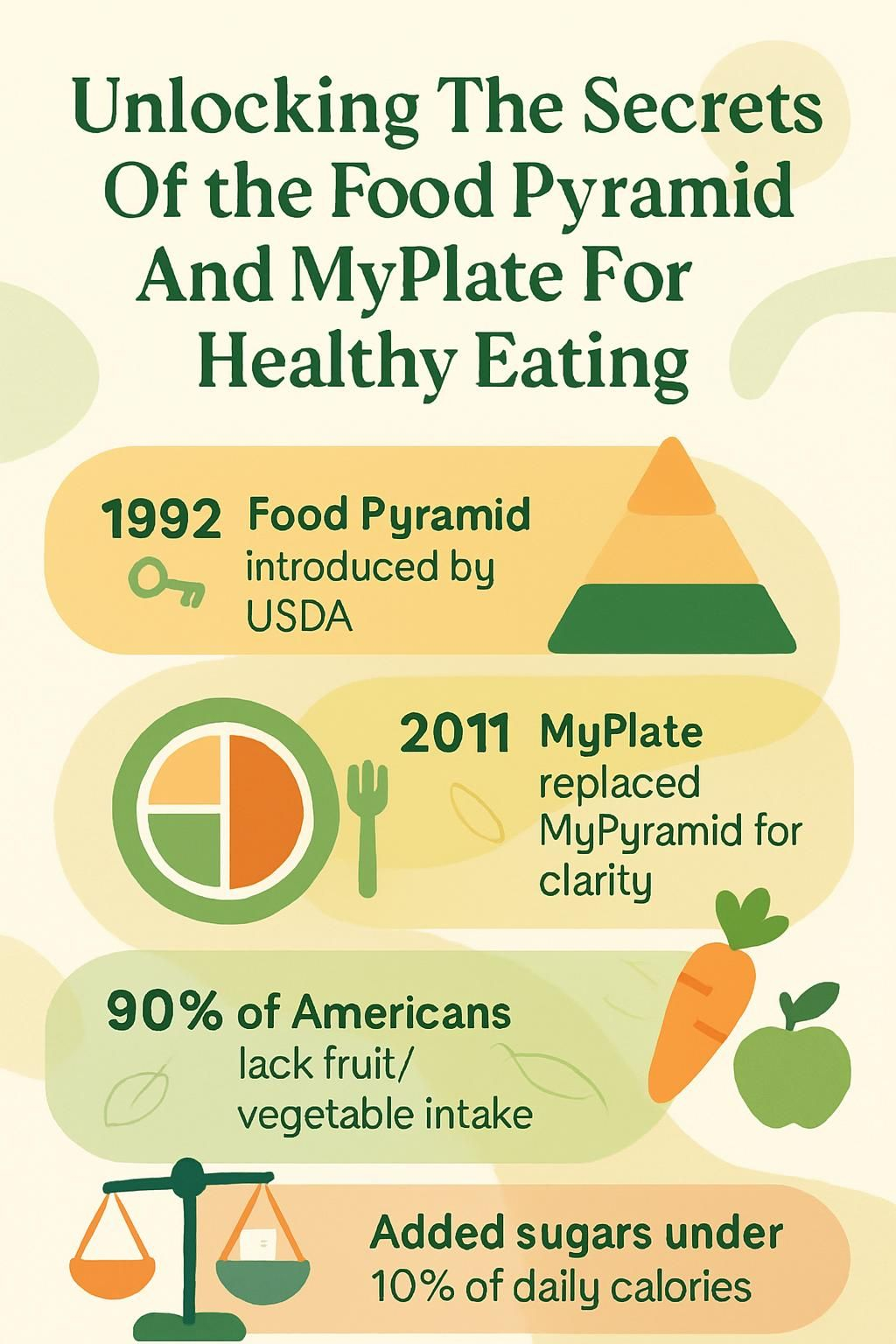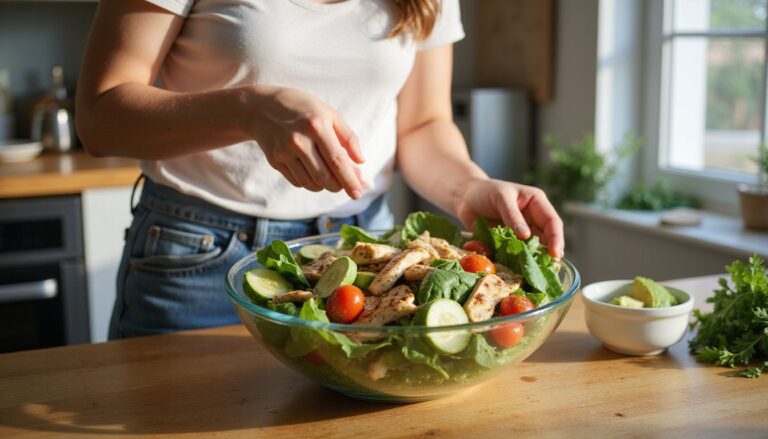Unlocking The Secrets Of The Food Pyramid And MyPlate For Healthy Eating
Our Nutrition Assistant AI Suite will transform your body. You will lose fat, get toned, and build muscle. Gain confidence and optimal health.
Many people feel unsure about healthy eating, especially with tools like the Food Pyramid and MyPlate. Guidance can clash, and the choices feel endless. This article explains both models, compares how they work, and shows simple ways to use them for healthy eating.
Nearly 90 percent of Americans fall short on fruits and vegetables, according to the United States Department of Agriculture. I break down what the Food Pyramid is, how it differs from MyPlate, and how to use these tools at home and on a budget.
Healthy habits start with clear information, and you will find practical steps here to build a better diet.
Key Takeaways
- The Food Pyramid, introduced by the USDA in 1992 and refreshed as MyPyramid in 2005, was replaced by MyPlate in 2011 for clearer meal guidance (USDA).
- MyPlate shows five groups on a plate: fruits, vegetables, grains, protein, and dairy. Half of the plate should be fruits and vegetables.
- Nearly 90 percent of Americans do not meet fruit and vegetable targets based on the Dietary Guidelines for Americans 2020–2025¹.
- Both models favor whole foods over processed items and advise keeping added sugar under 10 percent of daily calories (Dietary Guidelines for Americans).
- Following these patterns is linked with lower risks of heart disease, stroke by up to 26 percent, type 2 diabetes, and some cancers. They also support healthy weight maintenance².

What is the Food Pyramid?

The Food Pyramid is a visual food guide that shows the food groups and the amounts recommended each day. It was designed to help people plan a healthy diet that includes grains, vegetables, fruits, dairy, and protein foods such as meat or beans.
Where Did the Food Pyramid Originate and What Is Its Purpose?
Sweden created the first food guide pyramid in 1974 to support nutrition education and affordable meal planning. The USDA released the U.S. Food Guide Pyramid in 1992.
A diet rich in fruits, vegetables, grains and low-fat dairy can protect your heart
, said Walter Willett of Harvard’s School of Public Health. The pyramid arranged food groups to show relative amounts to eat, making choices easier to understand.
I saw that pyramid poster daily at school. Grains formed the base, then fruit and vegetables, then protein foods and dairy, with fats and sweets at the tip. It taught me that variety matters and that using all five food groups supports health.
What Is the Structure of the Original Food Pyramid (1992)?
The 1992 pyramid used horizontal layers to show six groups. Grains sat at the base, highlighting bread, rice, cereal, and pasta for energy and fiber. Above that were vegetables and fruits in separate bands, both stressing variety and vitamins like vitamin C and folate.
Two smaller levels near the top included protein foods, such as meat, poultry, fish, eggs, dry beans, and nuts, and also dairy foods like milk, yogurt, and cheese. The smallest tip held fats, oils, and sweets, which were to be used sparingly. The chart listed daily serving ranges, for example 6 to 11 servings of grains and 2 to 3 servings of protein foods.
I followed that structure for years until MyPyramid updated the look in 2005. The next section shows what changed.
How Was the Food Pyramid Revised in 2005?
In 2005, the USDA introduced MyPyramid. The design switched to colorful vertical bands for grains, vegetables, fruits, oils, milk, and meats or beans. A person climbing stairs on the side signaled daily physical activity.
MyPyramid moved toward personal needs based on age, sex, and activity level. It pushed whole grains more clearly and used thinner stripes for fats and added sugars to suggest moderation. Seeing portion guidance tied to my age and activity helped me plan meals with less guesswork.
Understanding MyPlate
MyPlate offers a simple, plate-based picture for building balanced meals. I like it because the visual makes choices at mealtime straightforward.
What Is MyPlate and Who Created It?
The USDA launched MyPlate in 2011 to make healthy eating easier to apply. The graphic shows a plate with five parts: fruits, vegetables, grains, protein foods, and dairy. Each part represents the share of the plate that food group should fill.
Experts built MyPlate from current nutrition science to address rising rates of overweight and chronic disease in the United States. It replaced the pyramid so people could plan meals by proportion instead of counting servings all day.
What Are the Five Food Groups in MyPlate?
- Grains: Make at least half your grains whole grains such as brown rice, whole wheat bread, oatmeal, or corn tortillas. Whole grains aid digestion and provide dietary fiber that supports steady blood sugar.
- Vegetables: Fresh, frozen, or lightly cooked options like leafy greens, carrots, and sweet potatoes add variety. Vegetables supply vitamins A, C, and K, plus minerals like potassium for bone and heart health.
- Fruits: Choices such as grapes, bananas, oranges, or 100 percent fruit juice deliver antioxidants and natural sugars for quick energy. Include whole fruit often for more fiber.
- Protein: Options include poultry, seafood, beans, lentils, nuts, seeds, tofu, and eggs. I rotate plant proteins with lean meats during the week for variety.
- Dairy: Milk, yogurt, cheese, or fortified dairy alternatives provide calcium and vitamin D for bones. Lactose-free and plant-based options help people who avoid dairy.
I have used MyPlate Kitchen to test recipes that balance these groups. It made planning simple and repeatable.
How Does MyPlate Differ from the Food Pyramid?
The 1992 Food Pyramid stacked foods by serving ranges, with grains at the base and fats at the tip. MyPlate splits a plate into sections you can copy at each meal. Half the plate should be fruits and vegetables, one quarter grains, one quarter protein, and a serving of dairy on the side.
This format makes meal building direct. For example, I might pair whole wheat bread with turkey, add a big salad, include orange slices, and serve low-fat milk. The picture helped me boost produce and limit saturated fat from deep frying.
Breaking Down the Food Pyramid
Understanding the original pyramid shows why each food group matters in a day’s meals.
What Are Grains and Whole Grains in the Food Pyramid?
Grains were the foundation of the 1992 pyramid, with 6 to 11 servings recommended per day. Whole grains such as brown rice, oatmeal, whole wheat bread, and barley offer more fiber and nutrients than refined grains like white bread or white rice.
The USDA now emphasizes whole grains because they support heart health and digestion. I often choose brown rice since it keeps me full longer than foods made with white flour. MyPlate suggests making at least half of all grains whole grains.
How Are Fruits and Vegetables Represented?
The pyramid placed fruits and vegetables near the base, showing their central role. It suggested 3 to 5 servings of vegetables and 2 to 4 servings of fruit daily. Studies link higher produce intake with lower risks of heart disease and some cancers.
On MyPlate, fruits and vegetables fill about half the plate together. I often steam broccoli or carrots to preserve nutrients and limit added salt. I also vary colors with spinach, tomatoes, apples, and berries for a wider range of vitamins and minerals.
What Does the Food Pyramid Say About Dairy and Alternatives?
The pyramid treated dairy and its alternatives as core sources of calcium, vitamin D, and protein. It suggested two to three servings a day, such as milk, yogurt, cheese, or fortified soy beverages.
I had trouble meeting calcium needs until I added yogurt and fortified non-dairy milk to my meals. For people with lactose intolerance or a vegan pattern, fortified soy or oat beverages can help meet calcium goals. One cup of milk has about 300 milligrams of calcium, which counts toward the 1,000 to 1,300 milligrams many people need each day based on age.
Which Protein Sources Are Included in the Food Pyramid?
Protein sources include both animal and plant foods. Lean meats like chicken and turkey, as well as fish, provide protein and important fats such as omega-3s. Eggs and dairy also supply essential amino acids, which are the building blocks of protein.
Beans, peas, lentils, nuts, tofu, and seeds are strong plant protein choices. MyPlate encourages varying proteins during the week. I plan meals around grilled fish one day and bean chili another to keep nutrients and flavors varied.
Why Should Fats, Oils, and Sweets Be Limited?
The pyramid placed fats, oils, and sweets at the top to stress limits. These foods are energy dense but offer fewer essential nutrients. Eating too many can raise the risk of weight gain, heart disease, and type 2 diabetes.
The Dietary Guidelines for Americans advise keeping added sugar under 10 percent of daily calories. MyPlate steers me toward mostly whole foods with little added fat or sugar. Small changes, such as skipping sugary drinks, helped me cut extra calories without losing taste.
Exploring MyPlate for Healthy Eating
Think of MyPlate as a quick blueprint for building a meal that works hard for your body.
What Are the Proportion Guidelines for a Balanced Plate?
Start simple. Fill half your plate with fruits and vegetables, leaning toward more vegetables. Use one quarter for grains, with at least half of those grains whole. Use the remaining quarter for protein such as chicken, beans, tofu, or fish.
Add a serving of low-fat dairy or a fortified alternative on the side. This structure helps me include each food group and keeps portions in check. USDA data show most people need more vegetables, so I plan meals around them first.
How Does MyPlate Emphasize Whole Foods and Nutritional Variety?
MyPlate favors whole foods that are closer to their natural form. It suggests whole fruit over juice and whole grains like oatmeal instead of refined grains. Dairy choices are low-fat or fat-free, with fortified soy beverages suggested for people who avoid dairy.
Each food group brings different vitamins, minerals, and fiber. Filling half my plate with colorful produce helps me hit daily nutrient targets. Varying protein sources such as beans, nuts, seafood, poultry, and lean meats adds balance across the week.
How Can You Customize MyPlate for Individual Dietary Needs?
Everyone has unique needs, so I adjust MyPlate to fit my health goals, culture, and preferences.
- Swap dairy for fortified soy milk or yogurt if you are vegan or lactose intolerant.
- Increase vegetables and fruits for weight management, and choose whole fruit over juice for more fiber.
- Add more lean proteins, such as beans, tofu, or fish, if you need extra protein for training or recovery.
- Pick whole grains like brown rice or oats to boost fiber or help manage blood sugar.
- Limit added sugars and saturated fat for heart health, and choose unsweetened foods and lean cuts.
- Follow your doctor’s or dietitian’s portion advice if you have diabetes, allergies, or nutrient gaps.
- Use culturally familiar foods within each group, such as quinoa instead of rice, to match taste and tradition.
- Track meals with online tools to see how closely you match MyPlate targets.
- Include more plant proteins if you eat vegetarian, for example lentils, chickpeas, nuts, and seeds.
- Adjust portions during high-activity weeks. I eat larger servings of grains and proteins during sports seasons.
- Review USDA Dietary Guidelines 2020–2025 for updates that can refine your plate choices.
Benefits of Following the Food Pyramid and MyPlate
These guides simplify daily choices and help you build habits that last.
How Do These Guides Improve Nutritional Balance?
The Food Pyramid and MyPlate show how much of each food group to choose. Using their portions helps me include fruits, vegetables, grains, protein, and dairy without overdoing calories.
USDA research links these patterns with fewer nutrient gaps. Following the suggested portions and choosing mostly whole foods boosts fiber and vitamins while keeping saturated fat lower. That balance supports long-term health.
How Can They Help Prevent Chronic Diseases?
Eating with these models is linked to lower risks of heart disease, type 2 diabetes, and some cancers. For example, five or more daily servings of fruits and vegetables are associated with up to a 26 percent lower risk of stroke.
Last year, I shifted to MyPlate-style meals. Six months later my blood pressure dropped from 140/90 mmHg to 120/80 mmHg. Small, steady changes worked without making me feel restricted.
How Do They Encourage Portion Control?
MyPlate uses the size of each plate section to signal how much of each group to eat. Vegetables and fruits together take half the space, which makes it easy to spot if I am short on produce.
The Food Pyramid provided daily serving ranges that also guide portions. Here are the classic serving targets from the 1992 pyramid:
| Food Group | Servings per Day |
|---|---|
| Grains | 6–11 |
| Vegetables | 3–5 |
| Fruits | 2–4 |
| Dairy | 2–3 |
| Protein | 2–3 |
| Fats and Sweets | Use sparingly |
Clear numbers and visuals help me avoid overeating without doing complicated math at the table.
How Do They Promote Plant-Based Diets?
Both guides put plant foods at the center. MyPlate calls for half the plate as fruits and vegetables, and it encourages beans and lentils as protein choices. The Dietary Guidelines also suggest replacing some red meat with seafood or plant proteins.
One day I filled half my plate with broccoli and carrots, added brown rice, and used black beans for protein. I had steady energy all afternoon. Research shows that eating mostly plant-based foods can lower LDL cholesterol and reduce heart disease risk².
Common Misconceptions About the Food Pyramid and MyPlate
Clearing up common myths makes it easier to build meals that match your goals.
What Are Common Misunderstandings About Serving Sizes?
People often confuse portion size with serving size. A single package may contain several servings, yet many people treat it as one. The Nutrition Facts label lists nutrients for one serving, not the whole package.
Foods like cereal or pasta can be tricky. Restaurant portions are often much larger than MyPlate portions. The CDC reports that many Americans underestimate how much they eat compared with recommendations, which leads to unplanned overeating.
Why Is Moderation Important and Often Overlooked?
Moderation is key even with healthy foods. I have seen how easy it is to overfill a plate with one group while skipping another. Moderation helps keep calories, sugar, and fat in balance across the day.
Large portions and heavy marketing can nudge people to eat more. The Dietary Guidelines for Americans warn that excess calories raise the risk of weight gain and chronic disease. Eating mindfully lets me enjoy treats in small amounts without losing balance.
How to Differentiate Between Processed and Whole Foods?
Processed foods often contain many ingredients and may include artificial colors, flavors, or preservatives. Manufacturers may add salt, sugar, or fat to improve taste and shelf life. A canned soup I checked had almost 800 milligrams of sodium per serving, while my homemade version used fresh vegetables and far less salt.
Whole foods stay close to their natural form and have short ingredient lists. Apples, spinach, brown rice, eggs, and plain yogurt are examples. Eating more whole foods aligns with MyPlate and makes portion control easier because you can see what you are eating.
Tips for Incorporating MyPlate into Daily Life
I use MyPlate to keep meals colorful and balanced without a lot of planning.
How Can You Plan Balanced Meals Using MyPlate?
Planning with MyPlate keeps variety and portions front and center. Use these steps at most meals:
- Fill half the plate with fruits and vegetables, with vegetables as the larger portion.
- Choose whole grains for at least a quarter of the plate.
- Save one quarter for lean protein such as poultry, fish, beans, or tofu.
- Add a serving of low-fat dairy or a fortified alternative.
- Use small amounts of oils like olive or canola instead of butter.
- Limit foods high in added sugar or sodium. Read labels on snacks and drinks.
- Adjust portions for age and activity level as the USDA suggests.
- Pick a rainbow of colors to increase nutrients across the week.
- Choose water as your main beverage instead of sugary drinks.
- Shop with a list that covers every MyPlate group to simplify prep.
How to Use MyPlate as a Grocery Shopping Guide?
I carry MyPlate in my head while shopping. It turns the store into clear sections that match the plate.
- List foods by the five groups: grains, vegetables, fruits, protein foods, and dairy.
- Pick mostly whole grains such as brown rice or 100 percent whole wheat bread.
- Fill half your cart with colorful produce to match the half plate goal.
- Choose lean proteins like skinless poultry, fish, beans, lentils, and nuts.
- Add low-fat or fat-free milk, yogurt, or cheese for calcium.
- Read labels to spot whole foods with less added sugar and sodium. Skip highly processed snacks.
- Select lactose-free dairy if needed, or fortified soy milk as a plant option.
- Limit sugary drinks. Choose plain water or low-sugar seltzer.
- Buy frozen or canned produce when fresh is limited. Choose no-salt-added vegetables and fruit packed in juice.
How to Adapt MyPlate for Vegan and Vegetarian Diets?
MyPlate adapts well to vegan and vegetarian patterns with a few swaps.
- Replace dairy with fortified plant milks, like soy or almond, to get calcium and vitamin D.
- Use beans, lentils, tofu, tempeh, or seitan for the protein quarter.
- Include many vegetable colors for a range of vitamins and minerals.
- Add fruit at every meal using fresh, frozen, or unsweetened dried options.
- Make at least half of grains whole grains such as quinoa or brown rice.
- Use nuts and seeds in small amounts for healthy fats and extra protein, including sources of omega-3s.
- Check plant-based labels for iron, B12, calcium, and zinc to cover harder-to-get nutrients.
- Choose leafy greens like spinach or kale often for iron and calcium.
- Plan ahead with MyPlate’s online tools to meet daily targets without gaps.
The Evolution of Dietary Guidelines
Diet advice keeps improving as research grows, which is why visual tools have evolved too.
How Have Dietary Guidelines Changed from Food Pyramids to MyPlate?
Experts moved from the 1992 pyramid to MyPlate in 2011. Many people found serving ranges hard to apply. A plate model is easier to copy on the spot.
Research from the USDA showed that people respond well to a graphic that fills half the plate with fruits and vegetables. MyPlate also aligns with current science, which supports more plant foods and fewer added sugars and unhealthy fats.
What Are Some Cultural Variations in Dietary Guidelines?
Countries shape guides around local foods and health needs. Japan uses a spinning-top image that favors rice, vegetables, fish, and soy. The Mediterranean Diet Pyramid highlights olive oil, seafood, and fruit-heavy desserts.
India’s guidance features grains and lentils, with a strong role for dairy. Nordic countries spotlight rye bread, root vegetables, and local fish. Each pattern shows how culture fits with healthy eating.
What Are Emerging Trends in Healthy Eating Patterns?
Plant-forward eating keeps growing. Sales of plant-based foods rose by 27 percent in the United States from 2019 to 2021. More people focus on whole grains, legumes, nuts, fruits, and vegetables while limiting red meat and processed foods. I also notice more vegetarian and vegan options at restaurants.
People care more about sustainability. Interest in local, seasonal, and organic items continues to rise. I use MyPlate to balance nutrition while choosing foods that fit both my health and environmental goals.
Conclusion
Learning how the Food Pyramid and MyPlate work has made my food choices clearer and more balanced. Both tools offer simple steps for portions and a variety of foods each day. Research links these patterns to lower risk of chronic disease and better weight control¹².
Use these guides as a starting point, then adjust for your needs, culture, and budget. This article is for education and does not replace advice from your healthcare professional or registered dietitian.
…
1. U.S. Department of Agriculture, Center for Nutrition Policy and Promotion, Dietary Guidelines for Americans
, 2020–2025.
2. Harvard T.H. Chan School of Public Health, Healthy Eating Plate and Healthy Eating Pyramid.
FAQs
1. What is the main difference between the Food Pyramid and MyPlate for healthy eating?
The Food Pyramid uses a tiered structure to show food group proportions, while MyPlate presents these groups as sections on a plate. Both tools guide balanced nutrition, but MyPlate offers a clearer visual of meal portions.
2. How do the recommended servings in the Food Pyramid compare to those in MyPlate?
The Food Pyramid lists daily serving ranges for each group such as grains or vegetables; MyPlate focuses on filling half your plate with fruits and vegetables at each meal. This shift helps people make healthier choices during meals rather than tracking servings throughout the day.
3. Why are whole grains and lean proteins important according to these guides?
Both models highlight whole grains and lean proteins because they provide essential nutrients like fiber, vitamins, minerals, and amino acids that support body functions. Research shows diets rich in these foods can lower risks of heart disease and diabetes (USDA 2020).
4. Can following either model help improve long-term health outcomes?
Studies confirm that using structured guides like the Food Pyramid or MyPlate leads to better diet quality over time (Harvard School of Public Health). For example, after switching from processed snacks to more fruit and vegetable-based meals inspired by MyPlate recommendations last year, I noticed higher energy levels during workdays.
Summary: The Food Pyramid and MyPlate both offer evidence-based frameworks for making nutritious choices; however, their approaches differ visually and practically. Choosing nutrient-rich foods from all groups supports lasting health benefits supported by scientific research.







